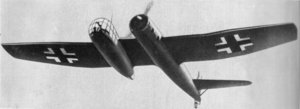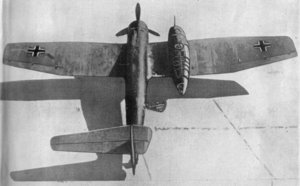Blohm & Voss BV 141
|
|
| Blohm und Voss Bv 141 | ||
|---|---|---|

| ||
| Description | ||
| Role | Reconnaisssance monoplane | |
| Crew | 3 | |
| First Flight | February 25, 1938 | |
| Entered Service | ||
| Manufacturer | Blohm + Voss | |
| Dimensions (Bv 141B) | ||
| Length | 14 m | 45 ft 9 in |
| Wingspan | 17.5 m | 57 ft 3 in |
| Height | 3.6 m | 11 ft 9 in |
| Wing Area | 43 m² | 463 ft² |
| Weights | ||
| Empty | 2,130 kg | 4,700 lb |
| Loaded | 2,590 kg | 5,700 lb |
| Maximum takeoff | kg | lb |
| Powerplant | ||
| Engine | BMW 801 | |
| Power | 1,160 kW | 1,560 hp |
| Performance | ||
| Maximum speed | 438 km/h @ 3,500 m | 272 mph @ 11,500 ft |
| Combat range | km | miles |
| Ferry range | km | miles |
| Service ceiling | m | ft |
| Rate of climb | 570 m/min | 1,860 ft/min |
| Wing loading | 60.2 kg/m² | 12.3 lb/ft² |
| Power/Mass | 448 W/kg | 0.274 hp/lb |
| Armament | ||
| Guns | 2 × MG 17 + 2 × MG 15 machine guns | |
The Blohm + Voss BV 141 is a World War II German tactical reconnaissance aircraft prototype. It is best remembered as the most asymmetrical aircraft to have ever flown.
In 1937, the Reichsluftfahrtministerium issued a specification for a single-engined reconnaissance aircraft with optimum visual characteristics. The preferred contractors were to be Arado, but the request prompted the Focke-Wulf company to work up the alternative idea of the Focke-Wulf Fw 189, a twin-boom design with two smaller engines and a central crew gondola, while Blohm + Voss proposed something far more radical. The proposal of chief designer Dr Richard Vogt was the unique asymmetric Bv 141.
The perspex glazed crew gondola on the starboard side housed the pilot, observer and rear-gunner, while the fuselage on the port side led smoothly from the 1000hp Bramo 123 engine to a tail unit (which was symmetrical in the Bv 141 V1 prototype).
It would seem that the displacement of lift vs weight, and thrust vs drag, would have induced tendencies to yaw and roll requiring continual trimming to control, but in fact the aircraft proved very stable and maneuverable. Indeed Dr Vogt had calculated that the greater weight on one side of the aircraft could be cancelled out by the torque of the propeller.
Three further prototypes and an evaluation batch of five Bv 141As were produced, but the assessment was that they were underpowered. By the time that a batch of five Bv 141Bs were built with the more powerful BMW 801 engines they were too late to make an impression, and the authorities proceeded instead to order production of the Fw 189. The Bv 141B had the starboard tail-plane virtually removed to improve the rear-gunner's field of view.
The Blohm + Voss team came up with several other asymmetric designs, but none were actually built.
| Related content | |
|---|---|
| Related development | |
| Similar aircraft | |
| Designation series |
BV 138 - Ha 139 - Ha 140 - BV 141 - BV 142 - BV 143 - BV 144 |
| Related lists | |
|
Lists of Aircraft | Aircraft manufacturers | Aircraft engines | Aircraft engine manufacturers Airports | Airlines | Air forces | Aircraft weapons | Missiles | Timeline of aviation |

